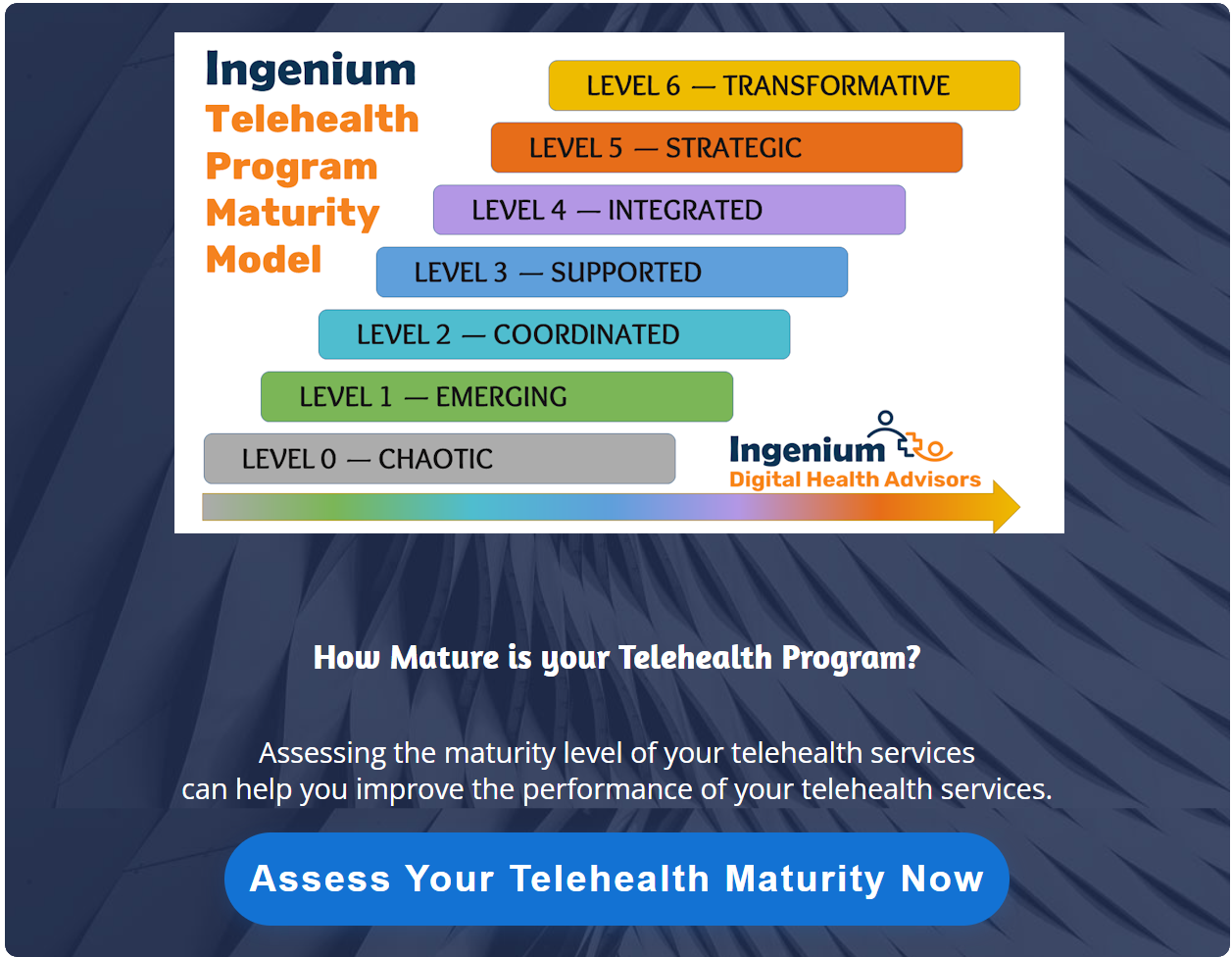While Telehealth has been around since the mid 1990s, albeit mostly in academic medical centers, an overnight adoption of telehealth across virtually all specialties and with numerous modalities was brought on by the Covid-19 health crisis in 2020.
While some clinics initially treated it as a convenient backup solution, most have by now accepted that telehealth is here to stay.
But how do you make it better? How can an organization get more value out of what is undoubtedly here to stay? What is needed to fully leverage telehealth’s potential?
Enter the 7 Levels of Telehealth Maturity, your roadmap to telehealth success.
On the Concept of Maturity
Usually we consider something fully mature when it has reached its highest level of potential. Yet often we equate maturity with age. While it is true that to achieve a certain level of maturity, we need to let some time pass, simply getting older does not mean we are getting more mature, because maturity comes from experience, not from age.
And therein lies the opportunity of telehealth maturity. While the process of progressing through the different levels of maturity is mostly sequential, it can be accelerated if you have good guidance to show you what aspects to focus on.
The 7-level Ingenium Telehealth Maturity Model is a representation of the various stages of maturity that healthcare organizations typically progress through on the way to the highest form of maturity: transformative. While one may be able to skip certain stages, more important than speed is to learn and understand the lessons of each stage.
Since maturity comes from experience it can also not simply be learned or taught: the organization has to actually live through the experiences to truly understand the lessons to be learned at each stage.
But rather than experiencing aimlessly and not knowing which aspects to improve, a maturity model provides a map, a sequence of increasing levels of maturity that can guide the learner to the next level.
On Maturity Models
Over the past decades, I have used a number of maturity models: starting in the 1990s with the Capability Maturity Model to describe software development processes, to self-designed maturity models for project management, requirements engineering, and now a telehealth maturity model.
The Ingenium Telehealth Maturity Model comprises 7 levels — from 0 to 6 — ranging from chaotic, emerging, and coordinated to supported, integrated, strategic and transformative.





While the maturity model may seem very formal and only applicable to large organizations, it actually is very scalable. It can be applied to single-specialty physician clinics, urgent care centers, or behavioral health agencies as well as rural and regional health systems or academic medical centers.
For the purpose of this discussion we’re describing the maturity levels from the perspective of a health system with designated leadership and support teams.
The 7 Levels of Telehealth Maturity
Level 0 — Chaotic: At this level new telehealth services (e.g., different scenarios, technologies, or modalities) are launched ad hoc and at times reactionary without much thought given as to the financial or clinical viability of the service. In larger organizations there is no coordination between the different telehealth services, with every clinician doing whatever they want.
Level 1 — Emerging: Eventually “word gets out” that different physicians or teams are using telehealth. Leadership is aware at some level and someone in IT is providing some technical support. Financial sustainability is typically expected or anticipated but seldom measured. Even 3 years after Covid, it’s not uncommon to have organizations still operating at this level.
Level 2 — Coordinated: This level is characterized by coordination and communication between the different clinicians and teams providing telehealth services. Leadership is typically supportive telehealth, but does not yet provide designated resources for support. Success is still mostly a function of a few individuals’ passion for making telehealth happen. Especially smaller or rural organizations are missing out on not having a designated telehealth coordinator.
Level 3 — Supported: At this level, a central support team (oftentimes comprising part-time assigned resources) is established with support by leadership. There is operational and technical support as well as formal support for the piloting and launch of new services and training new clinicians. At this level attention is also paid to reimbursement and regulatory compliance.
The “Supported” maturity level is the one that in the wake of the Covid-19 health crisis most health systems were striving toward. The next three maturity levels literally take telehealth “to the next level”, in the sense of how telehealth is being regarded by administrative and by clinical leadership and in turn by the whole organization.
Level 4 — Integrated: Once a centralized support team with best practices can manage the proper launch of new services, telehealth can quickly spread across all specialties (behavioral health, primary care, therapy, specialty care, etc.) and all modalities — whether to offer patients access to specialty care or integrating remote patient monitoring services. From a patient’s perspective, receiving care online across a spectrum of services is seamless. Finally, clinical data generated during telehealth visits or remotely collected is available for clinical decision making in the patient’s medical record.
Level 5 — Strategic: At the strategic level, organizations are fully leveraging telehealth by proactively using the launch of new telehealth services and the expansion of existing services to drive the fulfillment of their overall organizational strategic objectives. Engaging with patients at a distance and in person is the organization’s “new normal”.
Level 6 — Transformative: At the top maturity level, healthcare organizations are redefining care delivery by creating innovative care delivery models including virtual hospitals. Where necessary, transformative organizations design and develop their own telehealth solutions to meet their innovative needs. The organization is on a continuous pursuit of constantly reviewing and improving its telehealth capabilities and moving towards enabling “Empowered Wellness” for its patients by truly delivering connected care.
Using the Model – A Self Assessment
To use the model, as with any road map, you first need to assess where the organization is at, so you know where to go from here. Once an assessment of “you are here” is made, you can identify the gaps to get all aspects of one maturity level implemented.
For example in 2020 we started working with a behavioral health agency in rural Vermont that started out at the “2-Coordinated” level, reached “4-Integrated” by 2022 and now is well into level 5-Strategic.
If you’d like to conduct a quick self-assessment, you can do so here:



Looking Ahead
Over the next couple of weeks, I will be publishing two additional articles (“From Chaos to Supported: Growing Telehealth Maturity” & “Transforming Care Delivery through Telehealth”) on the Telehealth Program Maturity Model with more specifics on the upper levels and their benefits.










To receive articles like these in your Inbox every week, you can subscribe to Christian’s Telehealth Tuesday Newsletter.
Christian Milaster and his team optimize Telehealth Services for health systems and physician practices. Christian is the Founder and President of Ingenium Digital Health Advisors where he and his expert consortium partner with healthcare leaders to enable the delivery of extraordinary care.
Contact Christian by phone or text at 657-464-3648, via email, or video chat.






